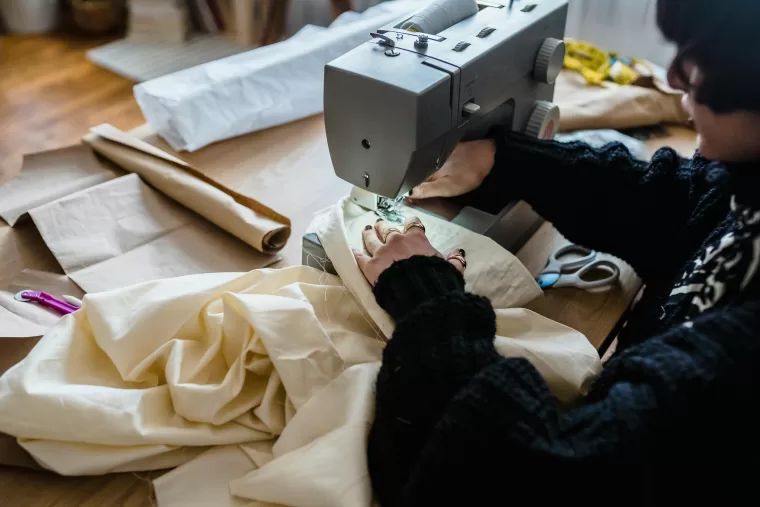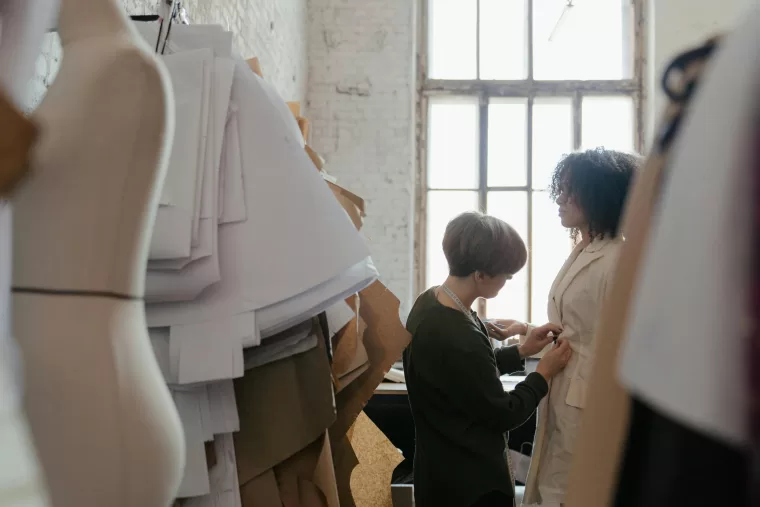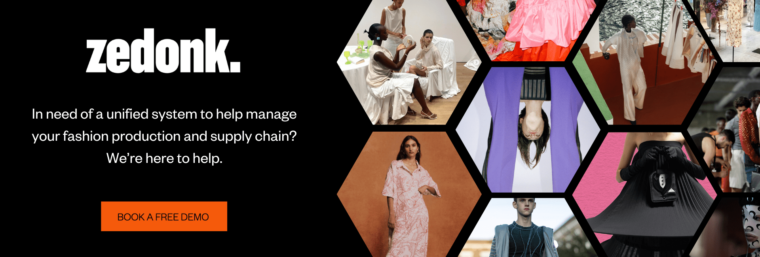There are many stages to effectively producing a garment. From initial concept to shop floor, the process of bringing clothes to life may not even occur to the casual wearer. But the way in which a garment is produced is at the core of what gives it its value.
This article will provide you with a comprehensive guide to understanding one of fashion’s key manufacturing processes, Cut Make Trim (CMT). We will emphasise what CMT clothing is, what CMT stands for in fashion-specific contexts, and how it compares to other forms of production.

What is CMT in Fashion?
CMT is an acronym for Cut Make Trim. It is one of the most common and most significant forms of manufacturing in the fashion industry. Understanding what CMT is in fashion and its significance is crucial for any growing business.
Once a garment is designed, CMT manufacturing is the next vital step in bringing visions to fruition on a larger, more marketable scale. It is important, therefore, for CMT manufacturers to be aware of every creative detail leading up to the production stage.
For most fashion brands, initial design stages will include sketching what a garment will look like, pattern making to outline shapes and measurements, and sampling to test the “real world” look and feel of the garment. Once these stages are complete, a detailed product blueprint, known as a Tech Pack, will be drawn up and sent to the CMT manufacturer in preparation for production.
CMT is most common among luxury and sustainable fashion businesses who work with small quantities of quality products. They pride themselves on precise cutting methods, skilled attention to detail, and careful waste management.
Breaking Down the CMT Process
As the name suggests, CMT manufacturing occurs in the following stages: cutting, making, and trimming. Each stage is broken down as follows:
Cut: The fabrics chosen by the designer are cut as per the sketched garment pattern. Each section is cut separately to ensure the proper measurements are produced. For instance, the collar of a shirt will have a different cut pattern to the sleeves. This stage is usually done using a cutting machine to ensure complete precision, but can occasionally be done by hand depending on the manufacturer and the requirements of the fashion brand.
Make: Manufacturers gather all of the newly-cut sections of a garment and stitch them together. This will create the form which we associate with a completed item of clothing. The make stage will be precisely and expertly executed by factory seamstresses, often using a sewing machine. For a more detailed or luxurious approach, stitching can also be done by hand or partially by hand to display premium production.
Trim: Once a garment has been sewn in its entirety, it’s time to add trims such as zippers, buttons, labels, and any other functional elements. Creative accents on a garment such as lace, embroidery, or appliqué will also be added at this stage. Trims not only give the garment full functionality, but also allow it to stand out aesthetically beyond a simple form.

The Role of CMT in Fashion Supply Chains
Because the Cut Make Trim process follows such a simple structure, it is easily adaptable into various business models. CMT manufacturers will work with brands of differing sizes; from small and emerging to bespoke and luxurious. Use of CMT in textile industries is also common.
This manufacturing process is not the only one dominating the industry, however. Full-package production (FPP) or “finished goods” manufacturing provides fashion businesses with a complete suite of product development; from material sourcing all the way to final shipping.
Despite their separation in the industry, it is not uncommon for some CMT manufacturers to also take on subcontracted orders from full-package production factories. Ultimately, their position in the fashion supply chain is crucial as a part of product creation – regardless whether a fashion business opts for CMT-only manufacture or not.
As with every integral decision a business makes, however, it is important to measure both the advantages and challenges of each manufacturing process to assess the best fit.
Advantages of CMT Production
There’s a good reason why Cut Make Trim is so popular among fashion businesses, and will likely only increase in popularity as sustainable production models become more prominent.
- If you’re a start-up fashion business or a new designer, CMT manufacturing is an excellent choice for getting started. CMT factories are generally very flexible and can easily accommodate lower volumes of orders.
- CMT manufacturers will often have expertise in specific technical processes and design techniques, making them ideal for high-quality or specialist product offerings.
- Alongside high-quality techniques, there is also a higher level of quality control amongst CMT manufacturers, largely due to the smaller pool of orders they’re working with at any given time. This allows for a greater attention to detail throughout the production process.
- Because CMT manufacturers aren’t in charge of the entire production process, there is greater supply chain transparency with fashion brands over each individual stage. Businesses are also able to maintain control by overseeing every aspect of their production; a benefit that is not shared by full-package manufacturing.
- Due to the low volume of orders CMT manufacturers require, make costs are usually a lot cheaper for fashion businesses with little stock compared to other forms of production.
Challenges of CMT Production
What is CMT clothing manufacturing, or indeed any form of manufacturing, without its set of challenges? CMT in textile and fashion, while widespread, is not the perfect fit for every business out there.
- The simplistic nature of the CMT process means that businesses must provide every detail they can about their garments to the factory before manufacture. Neglecting to include even the smallest of details can lead to designers receiving a product they did not initially envision – making documents like Tech Packs crucial for a streamlined production process.
- It is not uncommon for fashion businesses to outgrow CMT manufacturing as they scale. For businesses that are lucky enough to rapidly accelerate, production can quickly become difficult as CMT manufacturers struggle to keep up with the pace.
- Managing timelines can be more of a challenge with CMT, as businesses have to carefully plan each stage of the supply chain themselves, which can lead to a backlog. Fluctuations in cash flow and cost structures can also create timeline issues.

CMT vs Full-Package Production
While CMT manufacturing can offer significant flexibility and cost saving for certain business models, it can very quickly become expensive as orders grow to mass-production levels.
As a result, the majority of large-scale fashion companies opt for full-package production instead. FPP facilitates complete design, production, and logistic capabilities as well as synergy with in-house design teams, making them ideal for businesses with complex supply chains and strict timelines.
There are, however, much firmer rules in place with full-package production. Unlike CMT, flexibility and willingness to accommodate is rare due to the mass scale in which these factories operate.
Efforts toward sustainability are also greatly reduced through FPP, as wastage is scarcely regulated and supply chain transparency can be limited when manufacturers have full control. This can make it difficult for brands to declare their goods as sustainably sourced.
According to Mckinsey & Company’s 2024 State of Fashion report, the increasing “bullwhip effect” of volatility in supply chains means brands should, therefore, “consider investing in developing more transparent and collaborative relationships with their suppliers”. Choosing CMT manufacturing would facilitate this to a greater extent than FPP.
Optimising CMT Operations with Fashion ERP Software
In any manufacturing process, a well-managed supply chain is key. As Cut Make Trim requires many planning stages to reach full efficiency, tech tools like fashion ERP software can act as vital assets to businesses seeking this next step. These tools can:
- Provide full, real-time visibility: Use fashion ERP systems to manage your entire supply chain in one place and in real-time, from suppliers at the sampling stage to each CMT manufacturer.
- Minimise errors: Reduce the risk of backlogged timelines by improving communication across all channels.
- Produce documentation: Seamlessly generate all the relevant industry documentation necessary for CMT production.
- Calculate purchasing requirements: Steamline raw material purchases ahead of manufacture by automatically calculating your required bill of materials.
- Manage inventory: Keep on top of all your raw material and product inventories ahead of and during the production process.
At Zedonk, our specialist fashion ERP software can help your business with all these stages and more, enhancing your CMT operations and providing a complete, comprehensive overview. Book a demo here.


